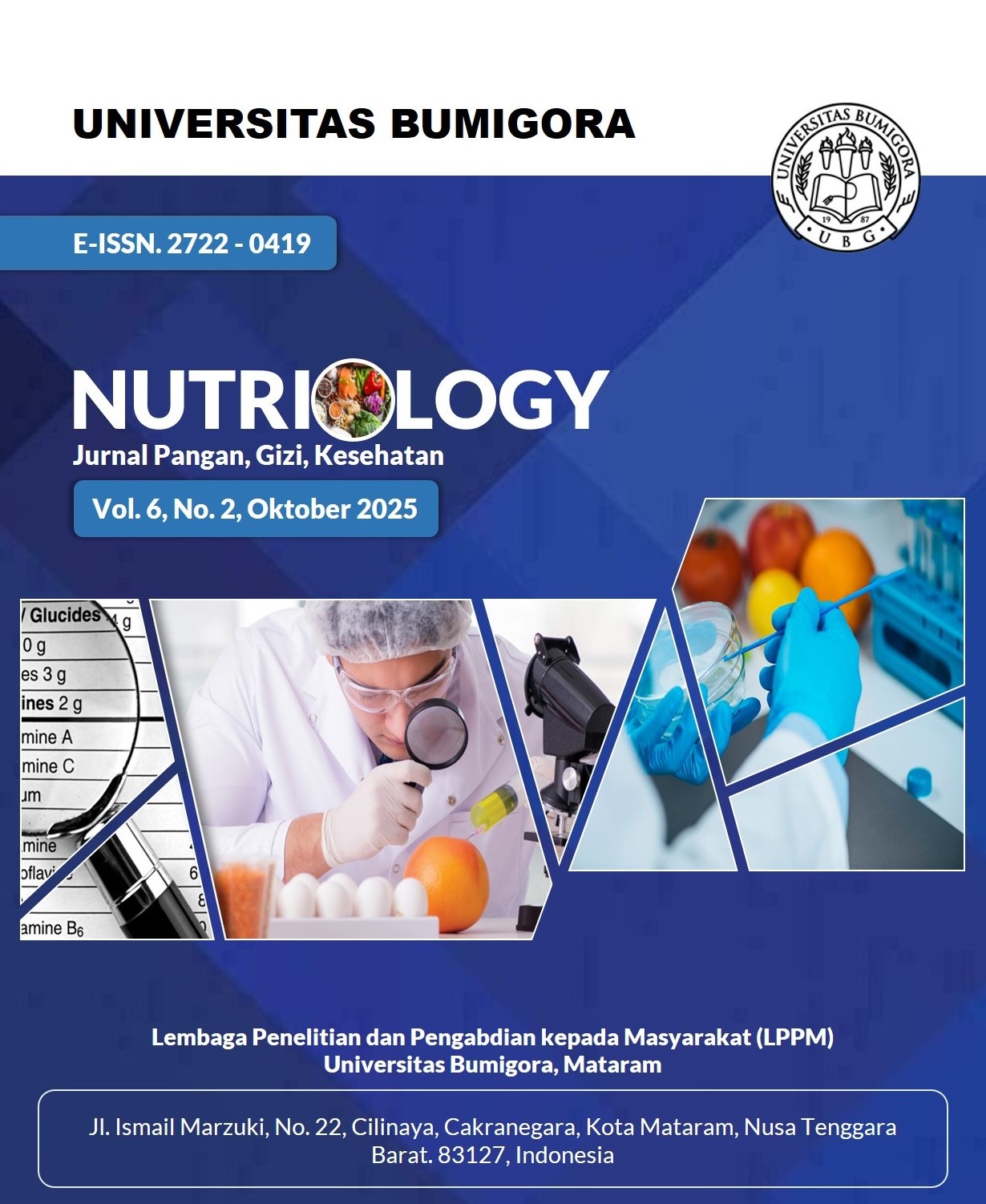Kekuatan Genggaman Tangan sebagai Indikator Awal Sarkopenia: Peran Status Gizi dan Faktor Sosiodemografi
DOI:
https://doi.org/10.30812/nutriology.v6i2.5614Keywords:
kekuatan genggaman, lansia, sarkopenia, sosiodemografi, status giziAbstract
The condition of age-related loss of skeletal muscle mass, accompanied by a decrease in muscle strength and/or physical performance, is defined as sarcopenia. Handgrip strength is an indicator for detecting possible sarcopenia. Nutritional status also plays an important role in influencing handgrip strength. The purpose of this study was to analyze the determinants of sociodemographic factors, nutritional status, and smoking habits on the risk of sarcopenia using handgrip strength as an indicator. This research method uses cross-sectional data from the 2023 Indonesia Longitudinal Aging Survey (ILAS). The research subjects were elderly people aged ≥60 years living in households. Handgrip strength assessed using the 2019 AWGS criteria. The results showed that advanced age, female gender, not working, and nutritional status, are associated with low handgrip strength as an indicator of sarcopenia risk (p < 0.05), while educational level and smoking habits do not show a significant association (p > 0.05). The conclusion is that age, gender, nutritional status, and employment status are important determinants of sarcopenia risk in the elderly. Prevention efforts should focus on adequate nutritional intake and early screening of muscle strength.
References
[1] A. E. Purwati, S. U. Asmarani, S. Wulan, R. Dewi, and N. Hidayat, “Peningkatan Kualitas Hidup Lansia melalui Pemeriksaan Tekanan Darah, Glukosa Darah dan Edukasi Menggunakan Media Informasi,” Kolaborasi Jurnal Pengabdian Masyarakat, vol. 3, pp. 164–169, 2023, doi: 10.56359/kolaborasi.
[2] W. Komalasari, A. Yulia, and K. W. Komalasari, “Hubungan Faktor Fisik, Psikologis Dengan Kualitas Hidup Lansia Di Air Camar Puskesmas Andalas Padang Tahun 2019,” Journal of Social and Economics Research, vol. 2, no. 1, 2020.
[3] L. A. Sholekah, E. Soesanto, and S. Aisah, “Hubungan Faktor Fisiologi pada Lansia dengan Resiko Jatuh di Dusun Wangil Desa Sambonganyar Kabupaten Blora,” Keperawatan dan Kesehatan Masyarakat, 2022.
[4] I. Shalahuddin, I. Maulana, T. Eriyani, and D. Nurrahmawati, “Latihan Fisik untuk Menurunkan Resiko Jatuh pada Lansia: Literatur Review,” Keperawatan Jiwa, vol. 10, 2022.
[5] L. K. Chen, J. Woo, P. Assantachai, T. W. Auyeung, and M. Y. Chou, “Asian Working Group for Sarcopenia: 2019 Consensus Update on Sarcopenia Diagnosis and Treatment,” Journal of the American Medical Directors Association, vol. 21, no. 3, pp. 300-307.e2, Mar. 2020, doi: 10.1016/j.jamda.2019.12.012.
[6] E. N. Njoto, “Sarkopenia pada Lanjut Usia: Patogenesis, Diagnosis dan Tata Laksana,” Jurnal Penyakit Dalam Indonesia, vol. 10, no. 3, Sep. 2023, doi: 10.7454/jpdi.v10i3.1444.
[7] Y. J. Go, D. C. Lee, and H. J. Lee, “Association between handgrip strength asymmetry and falls in elderly Koreans: A nationwide population-based cross-sectional study,” Archives of Gerontology and Geriatrics, vol. 96, Sep. 2021, doi: 10.1016/j.archger.2021.104470.
[8] V. G. Lumintang and A. H. Santoso, “Analisis kadar vitamin D dengan kekuatan genggaman tangan sebagai penanda sarkopenia pada lansia di Panti Wreda Bina Bhakti Pamulang,” Tarumanagara Medical Journal, vol. 7, no. 1, pp. 189–198, 2025.
[9] A. H. Santoso, D. Goh, and H. Sugiarto, “Deteksi Dini Sarkopenia secara dini melalui pemeriksaan kekuatan genggaman tangan dan antropometri pada guru dan karyawan SMA Santo Yoseph, Cakkukng, Jakarta Timur,” 2024.
[10] S. R. Rahayu, N. D. Putriningtyas, A. R. D. Candra, A. Azizan, and A. Azmi, “Sarcopenia in Indonesian Community-Dwelling Elderly: The Prevalence and Influencing Factors within the Primary Care Setting,” Unnes Journal of Public Health, vol. 14, no. 1, pp. 31–40, Mar. 2025, doi: 10.15294/ujph.v14i1.16058.
[11] A. H. Santoso, D. Goh, and H. Sugiarto, “Deteksi Dini Sarkopenia Secara Dini Melalui Pemeriksaan KekuatanGenggaman Tangan Dan Antropometri Pada Guru Dan Karyawan SMA SantoYoseph, Cakung, Jakarta Timur,” Human and Education, vol. 4, pp. 1423–1430, 2024.
[12] X. Jiang, F. Chen, X. Yang, M. Yang, and X. Zhang, “Effects of personal and health characteristics on the intrinsic capacity of older adults in the community: a cross-sectional study using the healthy aging framework,” BMC Geriatrics, vol. 23, no. 1, Dec. 2023, doi: 10.1186/s12877-023-04362-7.
[13] S. O. Lontoh, A. H. Santoso, I. Made, S. P. Jaya, and C. Gunaidi, “Edukasi dan Deteksi Dini Kekuatan Otot sebagai Prediktor Kejadian Sarkopenia pada Kelompok Lanjut Usia,” Jurnal Serina Abdimas, vol. 2, no. 3, pp. 884–889, 2023, doi: 10.24912/jsa.v2i3.32000.
[14] W. Susri, N. Maulina, and S. Nadira, “Hubungan Pekerjaan, Jenis Kelamin, Umur dan Aktivitas Fisik dengan Massa Otot pada Masyarakat Lhokseumawe,” Vitalis Medis: Jurnal Kesehatan dan Kedokteran, vol. 2, pp. 56–67, 2025, doi: 10.62383/vimed.v2i3.1722.
[15] N. D. P. Budiono and A. Rivai, “Faktor-faktor yang mempengaruhi kualitas hidup lansia,” Jurnal Ilmiah Kesehatan Sandi Husada, vol. 10, no. 2, pp. 371–379, Dec. 2021, doi: 10.35816/jiskh.v10i2.621.
[16] D. M. Hasyim, D. Asmaret, M. Sari, E. R. Ambarwati, and U. Zakka, “Sosialisasi Strategi Pola Hidup Sehat untuk Lansia,” Community Development, vol. 5, pp. 6974–6981, 2024, doi: 10.31004/cdj.v5i4.32264.
[17] R. Halim and S. Sukmaniah, “Hubungan antara Makronutrien dan Status Nutrisi dengan Kekuatan Genggaman Otot pada Lansia di Panti Werdha Jakarta,” Jambi Medical Journal, vol. 8, no. 2, pp. 127–134, 2020.
[18] H. Yu, Y. E. Kwon, S. I. Baeg, H. M. Choi, and D. J. Oh, “Sarcopenia, Nutritional Status And Mortality Risk Assessed Using Bioimpedance Spectroscopy In The Elderly Living In Long-Term Care Facility,” Clinical Nutrition ESPEN, vol. 54, 2023, doi: 10.1016/j.clnesp.2022.09.666.
[19] N. Nasimi, M. H. Dabbaghmanesh, and Z. Sohrabi, “Nutritional status and body fat mass: Determinants of sarcopenia in community-dwelling older adults,” Experimental Gerontology, vol. 122, 2019, doi: 10.1016/j.exger.2019.04.009.
[20] M. Locquet, O. Bruyère, L. Lengelé, J. Y. Reginster, and C. Beaudart, “Relationship between smoking and the incidence of sarcopenia: The SarcoPhAge cohort,” Public Health, vol. 193, pp. 101–108, Apr. 2021, doi: 10.1016/j.puhe.2021.01.017.
[21] M. Zheng, Y. Shao, C. Gong, Y. Wu, and W. Liu, “Association between smoking status and sarcopenia among middle-aged and older adults: finding from the CHARLS study,” European Geriatric Medicine, vol. 16, no. 1, pp. 79–88, Feb. 2025, doi: 10.1007/s41999-024-01101-y.
[22] M. Z. Darabseh, T. M. Maden-Wilkinson, G. Welbourne, R. C. I. Wüst, and N. Ahmed, “Fourteen days of smoking cessation improves muscle fatigue resistance and reverses markers of systemic inflammation,” Scientific Reports, vol. 11, no. 1, Dec. 2021, doi: 10.1038/s41598-021-91510-x.
[23] “Indonesia Longitudinal Aging Survey 2023,” 2025. doi: http://dx.doi.org/10.22617/TCS240416-2.
[24] K. Harimurti, S. Setiati, C. Heriawan Soejono, I. Suka Aryana, and S. Sunarti, “Sarcopenia in a Multiethnic State: A Cross-Sectional Data Analysis of Multicentre Indonesia Longitudinal Aging Study,” Acta Med Indones-Indones J Intern Med •, vol. 55, 2023.
[25] N. Albert Tambunan, A. Halim Santoso, F. Christian Gunaidi, A. Eka Prayoga Khoto, and E. Hartono, “Kegiatan Pengukuran Kekuatan Genggaman Tangan sebagai bagian dari Skrining dan Edukasi Kesehatan Otot Lansia,” Jurnal Pengabdian Kolaborasidan Inovasi IPTEKS, vol. 3, no. 3, p. 29863104, 2025.
[26] N. Rivianti, T. Indrajaya, R. Chodilawati, R. Dibyantari, and B. Indra, “Faktor-Faktor yang Berhubungan dengan Massa Otot, Kekuatan Otot, dan Performa Fisik pada Lansia,” Jurnal Penyakit Dalam Indonesia, vol. 12, no. 2, Jun. 2025, doi: 10.7454/jpdi.v12i2.1743.
[27] M. S. Vallejo, J. E. Blümel, P. Chedraui, K. Tserotas, and C. Salinas, “Risk of sarcopenia: A red flag for cognitive decline in postmenopause?,” Maturitas, vol. 194, Mar. 2025, doi: 10.1016/j.maturitas.2025.108193.
[28] L. S. Nasution, T. A. Wikaningtyas, T. Wahyuni, F. Farsida, and A. Muchlis, “Skrining Sarkopenia pada Masyarakat Lanjut Usia di Desa Kudukeras, Cirebon, Tahun 2023,” Jurnal Abdimas Kedokteran dan Kesehatan, vol. 2, no. 1, p. 25, Aug. 2024, doi: 10.24853/jaras.2.1.25-32.
[29] R. I. Sulistini, M. Khasifah, and H. D. Damanik, “Kekuatan Genggaman Tangan Pada Pasien Post Stroke,” Surya Medika, vol. 6, 2021, doi: 10.33084/jsm.vxix.xxx.
[30] F. Hidayat, A. H. Santoso, E. Destra, F. Averina, and H. Y. Putra, “Peran Pemeriksaan Handgrip Strength sebagai Sarana Skrining Risiko Penurunan Kekuatan Otot di Usia Produktif,” Kususma Jurnal Pengabdian kepada Masyarakat, pp. 90–97, 2025, doi: 1055656/kjpkm.v2i2.477.
[31] G. Chinvattanachot, D. Rivas, and G. Duque, “Mechanisms of muscle cells alterations and regeneration decline during aging,” Ageing Research Reviews, vol. 102, Dec. 2024, doi: 10.1016/j.arr.2024.102589.
[32] Y. C. Ko, W. C. Chie, T. Y. Wu, C. Y. Ho, and W. R. Yu, “A cross-sectional study about the relationship between physical activity and sarcopenia in Taiwanese older adults,” Scientific Reports, vol. 11, no. 1, Dec. 2021, doi: 10.1038/s41598-021-90869-1.
[33] L. A. T. Pham, B. T. Nguyen, D. T. Huynh, B. M. L. T. Nguyen, and P. A. N. Tran, “Community-based prevalence and associated factors of sarcopenia in the Vietnamese elderly,” Scientific Reports, vol. 14, no. 1, Dec. 2024, doi: 10.1038/s41598-023-50979-4.
[34] L. M. G. Verstraeten, A. Mashni, J. P. van Wijngaarden, C. G. M. Meskers, and A. B. Maier, “Sarcopenia knowledge of geriatric rehabilitation patients is low while they are willing to start sarcopenia treatment: EMPOWER-GR,” Journal of Cachexia, Sarcopenia and Muscle, vol. 15, no. 1, pp. 352–360, Feb. 2024, doi: 10.1002/jcsm.13372.
[35] S. Sumandar, R. Fadhli, and E. Mayasari, “Sosio-Ekonomi, Sindrom Metabolik terhadap Kekuatan Genggaman Tangan Lansia di Komunitas,” Jurnal Kesehatan Vokasional, vol. 6, no. 1, p. 61, Mar. 2021, doi: 10.22146/jkesvo.60813.
[36] A. S. Sim, A. H. Santoso, E. Destra, F. Y. Putra, and I. Felicia, “Skrining kekuatan genggaman tangan langkah awal cegah sarkopenia untuk populasi dewasa di SMP Kalam Kudus,” Journal of Community Service and Society Empowerment, vol. 3, no. 02, pp. 191–196, 2025, doi: 10.59653/jcsse.v3i02.1776.
[37] A. Gandham, A. Zengin, M. P. Bonham, S. L. Brennan-Olsen, and D. Aitken, “Associations between socioeconomic status and obesity, sarcopenia, and sarcopenic obesity in community-dwelling older adults: The Tasmanian Older Adult Cohort Study,” Experimental Gerontology, vol. 156, Dec. 2021, doi: 10.1016/j.exger.2021.111627.
[38] E. Cho, H. S. Soh, J. R. Lee, J. Yun, and W. K. Bae, “Association between smoking status and handgrip strength in Korean male adults: based on Korea National Health and Nutrition Examination Survey 2016–2019,” Frontiers in Medicine, vol. 10, 2023, doi: 10.3389/fmed.2023.1212946.
[39] L. W. Ribeiro, S. Berndt, G. I. Mielke, J. Doust, and G. D. Mishra, “Factors associated with handgrip strength across the life course: A systematic review,” Dec. 2024, John Wiley and Sons Inc. doi: 10.1002/jcsm.13586.
[40] C. Chalermsri, W. Aekplakorn, and V. Srinonprasert, “Body Mass Index Combined With Possible Sarcopenia Status Is Better Than BMI or Possible Sarcopenia Status Alone for Predicting All-Cause Mortality Among Asian Community-Dwelling Older Adults,” Frontiers in Nutrition, vol. 9, Jun. 2022, doi: 10.3389/fnut.2022.881121.
[41] M. Curtis, L. Swan, R. Fox, A. Warters, and M. O’Sullivan, “Associations between Body Mass Index and Probable Sarcopenia in Community-Dwelling Older Adults,” Nutrients, vol. 15, no. 6, Mar. 2023, doi: 10.3390/nu15061505.
[42] C. Liu et al., “The role of obesity in sarcopenia and the optimal body composition to prevent against sarcopenia and obesity,” Frontiers in Endocrinology, vol. 14, 2023, doi: 10.3389/fendo.2023.1077255.
[43] T. Neves, C. A. Fett, E. Ferriolli, M. G. Crespilho Souza, and A. D. dos Reis Filho, “Correlation between muscle mass, nutritional status and physical performance of elderly people,” Osteoporosis and Sarcopenia, vol. 4, no. 4, pp. 145–149, Dec. 2018, doi: 10.1016/j.afos.2018.11.081.
Downloads
Published
Issue
Section
License
Copyright (c) 2025 Hanna Nurjanah, Ernis Asanti, Fista Utami

This work is licensed under a Creative Commons Attribution 4.0 International License.










